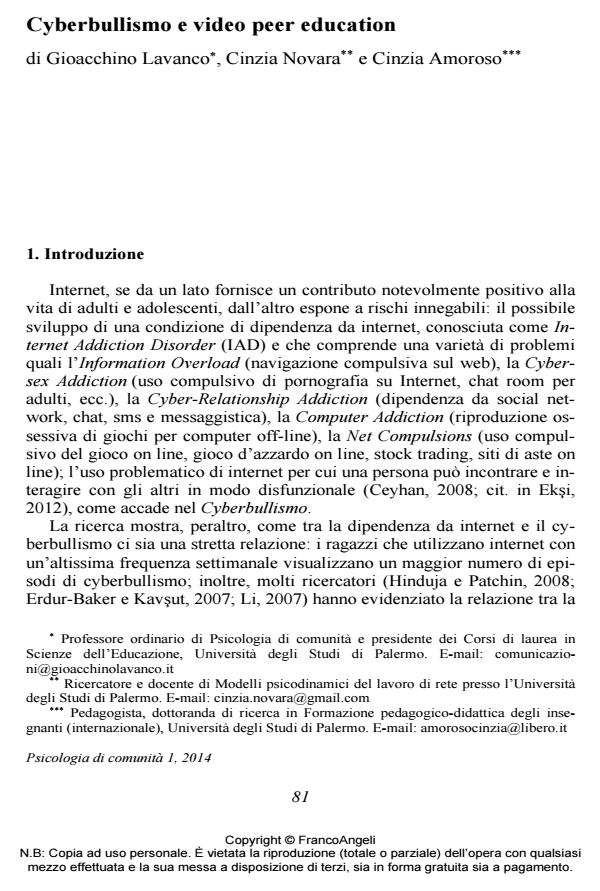Cyberbullying and peer education video
Journal title PSICOLOGIA DI COMUNITA’
Author/s Gioacchino Lavanco, Cinzia Novara, Cinzia Amoroso
Publishing Year 2014 Issue 2014/1
Language Italian Pages 10 P. 81-90 File size 59 KB
DOI 10.3280/PSC2014-001007
DOI is like a bar code for intellectual property: to have more infomation
click here
Below, you can see the article first page
If you want to buy this article in PDF format, you can do it, following the instructions to buy download credits

FrancoAngeli is member of Publishers International Linking Association, Inc (PILA), a not-for-profit association which run the CrossRef service enabling links to and from online scholarly content.
The aim of this article - through a process of action-research involving a sample of 243 subjects pre-teens and adolescents - is to highlight how the information medium can cause attacks, harassment, insults; but at the same time, it in use as a source of new communication strategies of group interaction and educational intervention in virtual communities. Cyberbullying is materialized in the lives of victims in each moment of the day and through different realities (video, photos, email, chat, sms, phone calls, ecc.). One of the methods of prevention, which looks at the group dynamics and the media technologies as a source of education, is the peer education video. The use of online materials as a method of prevention and awareness of educational agencies and proponents of the same and / or victims of cyberbullying.
Keywords: Cyber-bullying, traditional bullying, prevention, peer education video, new groups, modern educational dimensions.
- Croce M. e Gnemmi A., a cura di (2003). Peer education. Adolescenti protagonisti della prevenzione. Milano: Franco Angeli.
- Direttiva Ministeriale 3 Dicembre 1999, n.292, testo disponibile al sito:
- www.edscuola.it.
- Erdur-Baker Ö. and Kavşut F. (2007). Cyber bullying: a new face of peer bullying. Egitim Arastirmalari-Eurasian Journal of Educational Research, 27: 31-42, testo disponibile al sito: http://www.ejer.com.tr/index.php?git=archives&categori=62.
- Ekşi F. (2012). Examination of narcissistic personality traits’ predicting level of in- ternet addiction and cyber bullying through path analysis. Educational sciences: Theory and Practice, 12(3): 1694-1706, testo disponibile su http://files.eric.ed.gov/fulltext/EJ1000892.pdf.
- Fedeli D. (2007a). Il bullismo: oltre. Vol. 1: Dai miti alla realtà: la comprensione del fenomeno. Brescia: Vannini.
- Fedeli D. (2007b). Il bullismo: oltre. Vol. 2: Verso una scuola prosociale: strategie preventive e di intervento sulla crisi. Brescia: Vannini.
- Fedi A. e Mandalà M. (2005). La peer education: una prospettiva socio-educativa di lavoro con i giovani. In: Fedi A., a cura di, Partecipare il lavoro sociale. Esperienze, metodi, percorsi. Milano: Franco Angeli, cap. 2, pp. 44-57.
- Fonzi A. (2006). Bullismo. La storia continua… dal gioco crudele alla crudeltà violenta. Psicologia contemporanea, 197: 28-36.
- Hinduja S. and Patchin J.W. (2008). Personal Information of Adolescents on the Internet: A Quantitative Content Analysis of Overview of Cyberbullying MySpace. Journal of Adolescence, 31(1): 125-146. DOI: 10.1016/j.adolescence.2007.05.004,testodisponibilealsito:http://sfcs.cals.arizona.edu/azsearch/sites/sfcs.cals.arizona.edu.azsearch/files/Hinduja,%202008.pdf
- Lavanco G., Mandalà M. e Messina S. (2008). Peer or poor education? Quando il lavoro con i pari non basta. Quaderni di Animazione Sociale. Torino: Gruppo Abele, 153-160.
- Li Q. (2007). Bullying in the new playground: Research into cyberbullying and cyber victimisation. Australasian Journal of Educational Technology, 23(4): 435-454, testo disponibile al sito: http://www.ascilite.org.au/ajet/ajet23/li.html.
- Marini F. e Mameli C. (2004). Bullismo e adolescenza. Roma: Carocci.
- Menesini E. (2007). Strategie antibullismo. Psicologia contemporanea, 200: 18-25.
- Pisano L. e Saturno M.E. (2007). Prepotenze, devianza, criminalità minorile, psicopatologia: i confini incerti e confusi del bullismo. Cagliari: Punto di fuga.
- Pisano L. e Saturno M.E. (2008). Le prepotenze che non terminano mai. Psicologia contemporanea, 210: 40-45.
- Sutton J., Smith P.K. and Swettenham J. (1999). Bullying and “theory of mind”: a critique of the “social skills deficit” view of anti-social behaviour. Social Developmental, 8: 117-134.
- Vergati S. (2003). Bully kids. Socializzazione disadattate e bullismo fra i preadolescenti. Catania/Roma: Bonanno Editore.
Gioacchino Lavanco, Cinzia Novara, Cinzia Amoroso, Cyberbullismo e video peer education in "PSICOLOGIA DI COMUNITA’" 1/2014, pp 81-90, DOI: 10.3280/PSC2014-001007